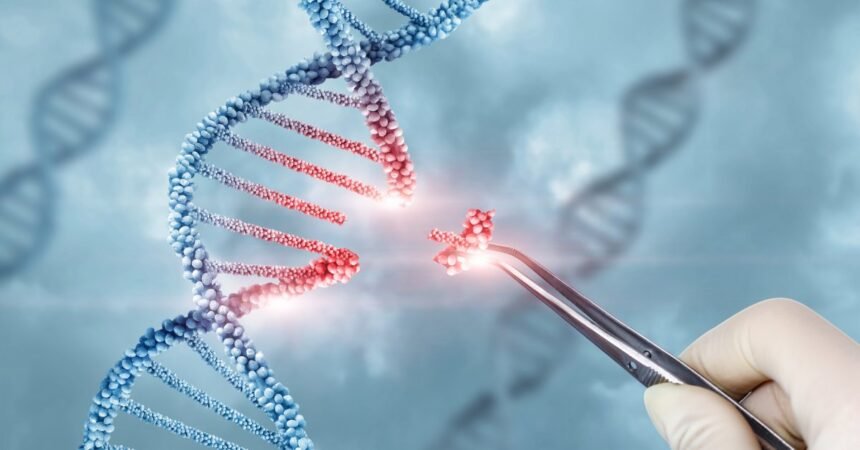Gene therapy has always held enormous promise to correct genetic diseases, but turning that potential into treatments has been challenging.
In a study published May 15 in the New England Journal of Medicine and presented at the American Society of Gene and Cell Therapy, researchers led by teams at Children’s Hospital of Philadelphia and University of Pennsylvania report on the first use of the gene-editing technology CRISPR in a customized therapy designed to treat one patient with a rare disease. CRISPR is already approved by the U.S. Food and Drug Administration (FDA) to treat sickle-cell anemia and beta thalassemia, in which patients receive the same gene therapy to treat an abnormality in their red blood cells.
In the latest case, the scientists developed a CRISPR treatment for a boy named KJ, who was born with genetic mutations in his liver cells that prevent him from breaking down proteins properly. As a result, ammonia builds up in his body, which can be toxic to the brain, potentially leading to developmental delays. Led by professor of medicine Dr. Kiran Musunuru at University of Pennsylvania, and Dr. Rebecca Ahrens-Nicklas, director of the Gene Therapy for the Inherited Metabolic Disorders Frontier Program at Children’s Hospital of Philadelphia, the scientists designed a CRISPR gene therapy to specifically address one of KJ’s mutations. “This drug was designed and made for KJ, so in reality this drug will probably never be used again,” says Ahrens-Nicklas of the bespoke nature of the therapy.
While the therapy was created for him, the team is hopeful that the process can be made more universal and applied to other genetic mutations, for which they can plug in the appropriate genetic change to correct a disease.
Read More: When to Go to the Emergency Room vs. Urgent Care
KJ’s treatment also differs in a few important ways from the approved CRISPR gene-editing treatment for sickle-cell anemia and beta thalassemia. That treatment involves removing cells responsible for generating blood cells from a patient, then genetically editing them using CRISPR to turn on a gene that makes fetal hemoglobin, which is normally turned off in adults. Once the blood stem cells are edited, they are then re-infused back into the patient. The idea is that these cells would start to make more copies of themselves and eventually generate enough healthy red blood cells to minimize or even eliminate the painful symptoms that patients experience.
In KJ’s case, CRISPR was moved from the lab into his own body. The work built on research Musunuru has been conducting to fix a genetic mutation in the PCSK9 gene responsible for increasing LDL cholesterol in some people. The mutation prevents their liver from pulling LDL cholesterol from the blood, which increases the risk of heart events for these patients. He and his team have been developing a therapy to not just turn on or turn off a gene using CRISPR, but to correct that gene by switching out one base pair in its DNA sequence, which is faulty, and replacing it with another base pair to restore the gene back to a normal state. In animals and early studies in people, the CRISPR therapy is successfully lowering cholesterol.
“As this work was taking off in the summer of 2021, we wondered about the ability to make changes in the liver and heal patients with other diseases, particularly rare diseases,” says Musunuru. “The same [CRISPR] technology used to turn off cholesterol genes could be used to correct misspellings in genes that cause other diseases.”
After connecting with Ahrens-Nicklas, it took two years for both teams—who also worked with companies including Aldevron, Integrated DNA Technologies (IDT), Acuitas Therapeutics, and Danaher Corporation—to figure out how to correct some of these misspellings responsible for rare diseases that threaten infants like KJ. The unique group of academic and company scientists was assembled with the help of scientists at the Innovative Genomics Institute at the University of California, Berkeley, which was created by CRISPR co-discoverer Jennifer Doudna. Aldevron took on the task of producing the actual CRISPR gene therapy product that KJ received, combining the RNA genetic sequence targeting KJ’s mutation, along with a guide RNA from IDT that directed the CRISPR to the right genetic sequence in KJ’s liver cells. The lipid nanoparticle from Acuitas delivered the therapy. And even though it was intended for just one patient, the treatment also had to receive clearance from the U.S. Food and Drug Administration.
Because it was so new, Ahrens-Nicklas and Musunuru decided to start KJ on a low dose of the gene-editing therapy when he was six months old, monitor his response for any adverse effects, and then provide two additional higher doses if all went well. He just received his third and final dose, and so far, seems to be responding.
“All of the milestones he is reaching, all of the developmental moments he is reaching, shows us that things are working,” said Nicole Muldoon, KJ’s mother, during briefing. “The prognosis for him was very different before we started talking about gene editing. We were talking more about comfort care, a liver transplant, and very severe delays due to the ammonia buildup and damage that could bring.”
Ahrens-Nicklas says it’s too early to tell exactly how effective the CRISPR therapy is. Because it’s too risky, the medical team is not planning to biopsy KJ’s liver to determine how many of his liver cells have been corrected by the CRISPR machinery. But they are monitoring other metrics to gauge its effectiveness, including his ammonia levels and measures of certain amino acids—like glutamine, which helps to break down proteins. “We don’t know how much benefit KJ received from this [therapy],” she says. “But the early signs are that he is probably a little more mild than he was going into [this treatment]. He had the most severe form of the most severe urea cycle disorder, and he is doing better at this point than we anticipate for someone with the most severe form of [this disease].”
She and Musunura plan to learn from KJ’s case, with an eye toward scaling up the platform to address other genetic disorders and shortening the time it takes to produce the customized therapy. In diseases like KJ’s, providing the treatment as early as possible reduces the chances of long-term damage and symptoms.
“I don’t think I’m exaggerating when I say that this is the future of medicine,” says Musunuru. “This is the first step toward using gene-editing therapies to treat a wide variety of rare genetic diseases for which there are currently no definitive medication treatments and in some cases, no treatments in development at all. We are showing it’s possible to make a personalized gene-editing therapy for a single patient in real time, and hope it inspires others to do the same. Some day, no rare disease patient will die prematurely from a misspelling in their genes that we are able to correct.”







